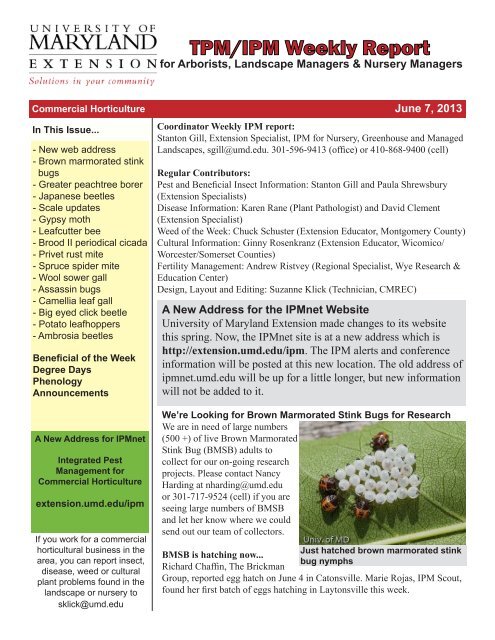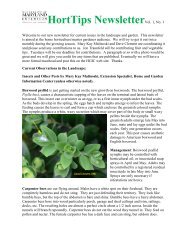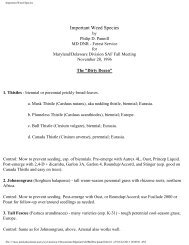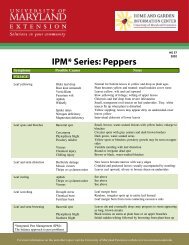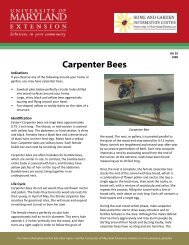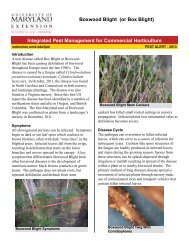13Jun07 - University of Maryland Extension
13Jun07 - University of Maryland Extension
13Jun07 - University of Maryland Extension
You also want an ePaper? Increase the reach of your titles
YUMPU automatically turns print PDFs into web optimized ePapers that Google loves.
TPM/IPM Weekly Report<br />
for Arborists, Landscape Managers & Nursery Managers<br />
Commercial Horticulture June 7, 2013<br />
In This Issue...<br />
- New web address<br />
- Brown marmorated stink<br />
bugs<br />
- Greater peachtree borer<br />
- Japanese beetles<br />
- Scale updates<br />
- Gypsy moth<br />
- Leafcutter bee<br />
- Brood II periodical cicada<br />
- Privet rust mite<br />
- Spruce spider mite<br />
- Wool sower gall<br />
- Assassin bugs<br />
- Camellia leaf gall<br />
- Big eyed click beetle<br />
- Potato leafhoppers<br />
- Ambrosia beetles<br />
Beneficial <strong>of</strong> the Week<br />
Degree Days<br />
Phenology<br />
Announcements<br />
Coordinator Weekly IPM report:<br />
Stanton Gill, <strong>Extension</strong> Specialist, IPM for Nursery, Greenhouse and Managed<br />
Landscapes, sgill@umd.edu. 301-596-9413 (<strong>of</strong>fice) or 410-868-9400 (cell)<br />
Regular Contributors:<br />
Pest and Beneficial Insect Information: Stanton Gill and Paula Shrewsbury<br />
(<strong>Extension</strong> Specialists)<br />
Disease Information: Karen Rane (Plant Pathologist) and David Clement<br />
(<strong>Extension</strong> Specialist)<br />
Weed <strong>of</strong> the Week: Chuck Schuster (<strong>Extension</strong> Educator, Montgomery County)<br />
Cultural Information: Ginny Rosenkranz (<strong>Extension</strong> Educator, Wicomico/<br />
Worcester/Somerset Counties)<br />
Fertility Management: Andrew Ristvey (Regional Specialist, Wye Research &<br />
Education Center)<br />
Design, Layout and Editing: Suzanne Klick (Technician, CMREC)<br />
A New Address for the IPMnet Website<br />
<strong>University</strong> <strong>of</strong> <strong>Maryland</strong> <strong>Extension</strong> made changes to its website<br />
this spring. Now, the IPMnet site is at a new address which is<br />
http://extension.umd.edu/ipm. The IPM alerts and conference<br />
information will be posted at this new location. The old address <strong>of</strong><br />
ipmnet.umd.edu will be up for a little longer, but new information<br />
will not be added to it.<br />
A New Address for IPMnet<br />
Integrated Pest<br />
Management for<br />
Commercial Horticulture<br />
extension.umd.edu/ipm<br />
If you work for a commercial<br />
horticultural business in the<br />
area, you can report insect,<br />
disease, weed or cultural<br />
plant problems found in the<br />
landscape or nursery to<br />
sklick@umd.edu<br />
We’re Looking for Brown Marmorated Stink Bugs for Research<br />
We are in need <strong>of</strong> large numbers<br />
(500 +) <strong>of</strong> live Brown Marmorated<br />
Stink Bug (BMSB) adults to<br />
collect for our on-going research<br />
projects. Please contact Nancy<br />
Harding at nharding@umd.edu<br />
or 301-717-9524 (cell) if you are<br />
seeing large numbers <strong>of</strong> BMSB<br />
and let her know where we could<br />
send out our team <strong>of</strong> collectors.<br />
BMSB is hatching now...<br />
Richard Chaffin, The Brickman<br />
Just hatched brown marmorated stink<br />
bug nymphs<br />
Group, reported egg hatch on June 4 in Catonsville. Marie Rojas, IPM Scout,<br />
found her first batch <strong>of</strong> eggs hatching in Laytonsville this week.
Greater Peachtree Borer, Synanthedon exitiosa<br />
Every year in June and July we get calls about cherry trees<br />
producing huge amounts <strong>of</strong> sap that harden on the trunk <strong>of</strong> tree. It<br />
is usually on the main trunk or at the base <strong>of</strong> the tree. One <strong>of</strong> the<br />
common causes <strong>of</strong> this sap oozing is from activity <strong>of</strong> the greater<br />
peachtree borer. The greater peachtree borer (Family Sesiidaeclearwing<br />
moths) is native to North America. It seems every other<br />
pest we report anymore is from areas <strong>of</strong> Asia, but this one is native.<br />
This borer usually is found infesting weakened native cherries in<br />
uncultivated areas.<br />
The peachtree borer can cause serious damage to peach, cherry,<br />
plum, nectarine, and apricot planted in your customers’ landscapes.<br />
One other plant we commonly see damaged by peachtree borer is<br />
cherry laurel. This plant is everywhere in commercial landscapes and <strong>of</strong>ten the plants are stressed from growing<br />
in poor soils or soils that are not properly irrigated (either too much or not enough water). The damage is caused<br />
by the larval stage as the larvae feed in the cambial tissue <strong>of</strong> the tree. Larvae can tunnel into the roots and lower<br />
trunks <strong>of</strong> the hosts and feed on the growing tissue and inner bark. Young trees may be completely girdled, and<br />
older trees may have their crop-bearing capacity greatly reduced. Peachtree borer infested trees may turn yellow<br />
and eventually die as the larvae girdle the tree at the crown. If you can dig the larvae out <strong>of</strong> the trunk it will be a<br />
creamy white color with golden colored crotchets (hooks) in parallel lines on each <strong>of</strong> the prolegs. The insect has<br />
a one-year life cycle in the tree and adults emerge out around 570 degree days. Many areas have reached this<br />
benchmark at this point in the season.<br />
Prevention is Key to Control: Keeping trees healthy and avoiding stressing trees is the best way to prevent<br />
problems with peachtree borer. Avoid wounding the base <strong>of</strong> the plant and certainly avoid removing sucker<br />
shoots at this time <strong>of</strong> year since this gives a wound site to attract the peachtree borer. Trees growing in heavy,<br />
poorly drained soil and extremely dry sights are more likely to have problems with peachtree borer infestations.<br />
If preventative insecticides are applied to the trunk then now is the time <strong>of</strong> year to apply them. There really is<br />
not much labeled for home fruit bearing trees to prevent borers. Ornamental cherry, plum, apricot and cherry<br />
laurel can be treated with bifenthrin (Onyx) or Permethrin (Astro).<br />
Japanese Beetles<br />
In digging in soil in Olney we found mainly late instar larvae<br />
present on June 2 and a few pupal stages <strong>of</strong> Japanese beetles. One<br />
adult was found on crabapple here at the research center in Ellicott<br />
City on June 6. We should start to see emergence <strong>of</strong> adults in the<br />
next week or so. If you find adult Japanese beetles (look for them<br />
on roses and grape vines), let us know. Send an email to sgill@<br />
umd.edu<br />
View <strong>of</strong> underside <strong>of</strong> peachtree borer<br />
showing the crochets (hooks)<br />
Progress in Biological Control <strong>of</strong> Emerald Ash Borer<br />
The Canadian Food Inspection Agency just approved release <strong>of</strong> two parasites <strong>of</strong> emerald ash borer in Canada.<br />
The two Asian wasp species now approved by the CFIA are Tetrastichus planipennisi <strong>of</strong> the eulophid family<br />
and Spathius agrili <strong>of</strong> the braconid family. The Eulopid wasp lays eggs into the larvae <strong>of</strong> emerald ash borer and<br />
acts as internal parasite. Both species have already been introduced in Michigan with favorable results. This<br />
biological control is probably one <strong>of</strong> the best long term control methods for dealing with this invasive borer.<br />
2
Scale Updates<br />
Oak lecanium scale (s<strong>of</strong>t scale): Monitoring <strong>of</strong> oak<br />
lecanium scale on pin oak on Thursday in College Park<br />
found high populations where ~ 90% <strong>of</strong> the eggs had<br />
hatched, the majority <strong>of</strong> the first instars were crawlers,<br />
and a small proportion had settled onto the underside<br />
<strong>of</strong> the foliage. Degree days in College Park as <strong>of</strong> June<br />
5 were 953 DD. Paula was also seeing parasitoid larvae<br />
under the some <strong>of</strong> the females so there is natural enemy<br />
activity too. We received additional reports <strong>of</strong> crawlers:<br />
Richard Chaffin, The Brickman Group, found them on<br />
June 4 in Catonsville and Jeff Schwartz, Ashton Manor<br />
Environmental, found them in Howard County this<br />
week.<br />
Monitoring: Check the degree day accumulations in<br />
your area. If they are close to 953 DD you should look<br />
(using a hand lens) for: active crawlers on the branches;<br />
active crawlers and settled first instars on the leaves;<br />
flip the female scale bodies over and determine if she<br />
still has eggs under her or if the eggs have hatched. If<br />
the majority <strong>of</strong> the eggs have hatched / are crawlers and<br />
settled firsts (as we are seeing in College Park) it is time<br />
to apply a pesticide. For optimal control, under these<br />
conditions, applications should be applied within the<br />
next 7-10 days.<br />
Control: Distance or Talus (IGRs) are preferred,<br />
pyrethroids should work but are harder on natural<br />
enemies.<br />
White prunicola scale (WPS, armored scale):<br />
Monitoring WPS populations on cherry trees on<br />
Oak branch heavily infested with lecanium scale<br />
Photo: Jeff Schwartz, Ashton Manor Environmental<br />
Close-up <strong>of</strong> lecanium scale crawlers<br />
Photo: Richard Chaffin, The Brickman Group<br />
Tuesday June 4th in Laytonsville found settled crawlers (1st instars) and 2nd instar adults. Degree day (DD)<br />
readings in Laytonsville as <strong>of</strong> June 4th were 656 DD.<br />
Control: Once all WPS scales reach the 2nd instar adult stage they are hard to control. Therefore, you should<br />
consider applying a control sooner than later.<br />
Japanese maple scale (JMS, armored scale): Monitoring <strong>of</strong> JMS in Laytonsville on Tuesday June 4 found<br />
a lot <strong>of</strong> adult females with eggs, but NO crawlers at this time. Degree day (DD) readings in Laytonsville as <strong>of</strong><br />
June 4th were 656 DD. We expect to see crawlers soon and will continue to monitor to let you know when they<br />
are active.<br />
Juniper scale (armored scale): Monitoring <strong>of</strong> juniper scale found crawlers are in full swing this week in<br />
Keedysville. Crawlers are out and starting to settle at 706 DD. Of the 40 scales checked, 23 were alive and 13<br />
were dead. (However, some dead female scale had a few live eggs under cover). There were 22 crawlers and 12<br />
settled 1st instars observed, and four (4) scales were parasitized.<br />
Indian wax scale (s<strong>of</strong>t scale): Monitoring <strong>of</strong> Indian wax scale on June 3 in Columbia (590 DD) found seven<br />
samples pulled have eggs, but no crawlers yet. Three had no eggs and the females under the covers were dead.<br />
3
Gypsy Moth Activity<br />
Teri Batchelor, <strong>Maryland</strong> Department <strong>of</strong> Natural Resources, reported that<br />
Brian Young, Special Rivers Forester, verified there is a 2-acre severe gypsy<br />
moth defoliation site on Kent Island. It is the first in 19 years that she has seen<br />
them in Kent/Queen Anne’s counties. John Smithmyer, Bartlett Tree Experts,<br />
sent in a photo <strong>of</strong> a blue spruce in Elkton that was heavily damaged by gypsy<br />
moths.<br />
Blue spruce heavily defoliated by gypsy moth larvae<br />
Photo: John Smithmyer, Bartlett Tree Experts<br />
Leafcutter Bees<br />
On a rainy Friday morning, a person brought in<br />
an interesting sample. It was rolled up leaves that<br />
were rolled like a cigar. Inside the leaf tissue was<br />
packed with pollen and an egg. The egg was from<br />
a leafcutter bee. In June, we <strong>of</strong>ten get samples <strong>of</strong><br />
roses that have perfectly scalloped cuts removed<br />
from the foliage which is usually from the activity<br />
<strong>of</strong> the leafcutter bee gathering leaf tissue to shape<br />
into its nest. Although they cut many types <strong>of</strong><br />
leaves, leafcutter bees prefer certain types, notably<br />
rose, green ash, lilac and Virginia creeper. This<br />
injury <strong>of</strong>ten is only a minor curiosity. After the nest<br />
is selected the leafcutter bees collect fragments <strong>of</strong> leaves to construct individual nest cells. The bees cut leaves<br />
in a distinctive manner, making a smooth semicircular cut about 3/4 inch in diameter from the edge <strong>of</strong> leaves.<br />
Leafcutter bees carry these cut pieces <strong>of</strong> leaves back to the nest and use them to make nest cells within the<br />
previously constructed tunnels. Then, they provision each leaf-lined cell with a mixture <strong>of</strong> nectar and pollen.<br />
The female lays an egg and seals the cell, producing a finished nest cell that somewhat resembles a cigar butt.<br />
A series <strong>of</strong> closely packed cells are produced in sequence. A finished nest tunnel may contain a dozen or more<br />
cells forming a tube 4 to 8 inches long. The young bees develop and remain within the cells, emerging the next<br />
season. This is an interesting insect in the landscape and one that does not need to be controlled. In fact it is a<br />
great pollinator.<br />
Periodical Cicada Update – Brood II<br />
The activity from Brood II cicada in St. Mary’s county is evidently winding down. We received this report from<br />
Peggy Milliman, Friendship Forest Christmas Tree Operation in Oaksville, <strong>Maryland</strong> (St. Mary’s County). She<br />
reported on June 5 that “it’s getting quiet and only a few dead bugs to pick <strong>of</strong>f here and there. I imagine the<br />
season is wrapping up.”<br />
4
Privet Rust Mite<br />
You have to have good eyes to pick up these small<br />
mites feeding on the undersides <strong>of</strong> private foliage.<br />
What caught Steve Sullivan’s (The Brickman<br />
Group) eye was that the California privet in<br />
Catonsville was half defoliated. When you look<br />
at the undersides <strong>of</strong> the foliage with 20 - 30<br />
magnification you will see a sausage-shaped mite<br />
called a privet mite. These mites are cool weather<br />
mites and have been feeding for the last couple <strong>of</strong><br />
months on the foliage. The cool wet spring has been<br />
perfect for this mite. As we move into the heat <strong>of</strong><br />
the summer, the activity <strong>of</strong> these eriophyid mites<br />
generally dies down. They will become active again<br />
when it cools down in fall.<br />
Monitoring: Look for these elongated mites with<br />
four legs on the undersides <strong>of</strong> foliage. Use at least<br />
20 X magnification to see the mites.<br />
Control: Abamectin (Avid) or horticultural oil at<br />
1 % summer rate will control these mites.<br />
Damage on privet from privet rust mite<br />
Photo: Steve Sullivan, The Brickman Group<br />
Spruce Spider Mite<br />
We are also receiving reports <strong>of</strong> spruce spider mite activity. This mite is another cool season mite and has been<br />
active on junipers.<br />
Wool Sower Gall<br />
Wayne Noll, City <strong>of</strong> Rockville, sent a photo <strong>of</strong> wool sower gall which<br />
is caused by secretions <strong>of</strong> the grubs <strong>of</strong> a small gall wasp, Callirhytis<br />
seminator. Generally, wool sower gall is specific to white oak and only<br />
occurs in the spring. The galls contain seed-like structures. The gall wasps<br />
develop inside these structures. It’s harmless and you do not have to do<br />
anything.<br />
Wool sower gall on oak<br />
Photo: Wayne Noll, City <strong>of</strong> Rockville<br />
Assassin Bugs<br />
Jenn Rodriguez, Ruppert Landscape, and Crystal Mutzabaugh, Good’s Tree<br />
Care, sent in photos <strong>of</strong> recently hatched assassin bug nymphs. These bugs<br />
are general predators that feed on a variety <strong>of</strong> other insects and insect eggs<br />
in the landscape and nursery.<br />
Assassin bug nymphs by an egg mass<br />
Photo: Jenn Rodriguez, Ruppert Landscape<br />
5
Camellia Leaf Gall<br />
Bill Miller, The Azalea Works, sent in a series <strong>of</strong> photos <strong>of</strong> the camellia leaf gall on Camellia oleifera ‘Snow<br />
Flurry’. We reported on this gall in the May 24, 2013 report.<br />
Camellia leaf gall on Camellia oleifera ‘Snow Flurry’<br />
Photos: Bill Miller, The Azalea Works<br />
Big Eyed Click Beetle (Alaus oculatus)<br />
Craig Greco, Yardbirds, Inc., sent in a photo a an adult big eyed<br />
click beetle. The larvae <strong>of</strong> these beetles are predaceous and feed<br />
on wood boring larvae. Look for theses beetles under logs and<br />
in other damp places. The adults feed very little, if at all.<br />
Big eyed click beetle that is well<br />
camouflaged on bark<br />
Photo: Craig Greco, Yardbirds, Inc.<br />
Potato Leafhoppers<br />
Marie Rojas, IPM Scout, is seeing a lot <strong>of</strong> potato leafhoppers on red maples<br />
in Montgomery County this week. Potato leafhopper feeding causes the tip<br />
growth on maples to curl over and harden which is typically referred to as<br />
‘hopperburn’. The multiple generations keep damaging the new tip growth<br />
that flushes out on the maples. The leafhoppers migrate from the south and<br />
feed on new growth. Females will lay eggs on tip growth and the nymphs<br />
will be feeding in the next couple <strong>of</strong> weeks.<br />
Control: Soil drench applications include Thiamethoxam (Flagship),<br />
Imidacloprid (Marathon and other trade names now that the patent has<br />
expired), Dinotefuran (Safari), and Cyfluthrin (Discus). You can also make<br />
foliar applications <strong>of</strong> Acephate (Orthene) but this would have to be repeated<br />
for the multiple generations that occur over the summer. Acetamiprid<br />
(Tristar), Discus and Kontos can also be applied as a foliar spray in nursery<br />
beds.<br />
6
Ambrosia Beetles<br />
We had the second spike in ambrosia beetles, mainly Xylosandrus crassiusculus, two weeks ago here at the<br />
research center in Ellicott City and at sites in Adamstown and Beallsville. Since then, we continue to pick<br />
up low numbers <strong>of</strong> adult ambrosia beetles as shown in the chart below. We received an email and call from a<br />
graduate intern <strong>of</strong> the Virginia Chestnut Society, Northern Branch, to let us know they were finding ambrosia<br />
beetles attacking several <strong>of</strong> their hybrid chestnuts during this last spike in adult activity. They had lost over 30<br />
trees to the ambrosia beetle attacks at one planting site. Earlier, we had reported that several nurseries also saw<br />
damage on trees during this last spike <strong>of</strong> flight activity. The good news this week is that the adult population is<br />
staying low at the three sites we are monitoring. We should be getting late enough into the season in which we<br />
generally don’t see damage from the 2nd and 3rd generations <strong>of</strong> ambrosia beetles.<br />
Beneficial <strong>of</strong> the Week, Paula Shrewsbury<br />
Parasitic wasps attack armored and s<strong>of</strong>t scales – signs <strong>of</strong> parasitism<br />
When I think <strong>of</strong> the key pests in our industry scales, both s<strong>of</strong>t and armored species, are always near the top <strong>of</strong><br />
the list. There is something about “managed” environments such as our production nurseries and landscapes<br />
that favor scale insects and / or disfavor natural enemies. This is clearly demonstrated by the many scale species<br />
we discuss in our weekly report. Even though scales can be very abundant and sometimes damaging things<br />
could be worse. For many scales there are natural enemies that attack and kill them. Things however could be<br />
better too. For example, the white prunicola scale that we have been monitoring had parasitic wasps that were<br />
attacking and killing them but I estimate they were attacking less than 10% <strong>of</strong> the population… not enough!<br />
That is why I promote conservation <strong>of</strong> natural enemies to increase their densities and impact on scales and other<br />
pest insects. For example, adding flowering plants can provide resources such as nectar, pollen, and refuge for<br />
natural enemies. Pesticides should be selected not only based on their efficacy against the pest but also for their<br />
impact on natural enemies. This is especially critical if there are “signs” <strong>of</strong> parasitoid activity on your scale<br />
populations. How do you know if parasitoids are attacking the scales on your trees and shrubs? It usually is<br />
NOT by seeing adult wasps – they are very tiny - making them difficult to see. Adults are fast moving and the<br />
immature stages <strong>of</strong>ten develop within its insect host making it difficult to monitor for parasitoid activity by<br />
watching for adults or larvae. You have to look for “signs” <strong>of</strong> parasitism. When some insects such as aphids<br />
or whiteflies are parasitized there is <strong>of</strong>ten a change in color and/or size <strong>of</strong> the insect. Think <strong>of</strong> aphid mummies<br />
where the parasitized aphid looks “bloated” and usually tan or darkened in color. Unfortunately most scales do<br />
not change in size and color. A more universal sign is a discrete circular hole in the cover <strong>of</strong> the armored scale<br />
(see images), or body <strong>of</strong> the s<strong>of</strong>t scale. When wasps reach the adult stage within their host’s body, they then<br />
7
chew their way out to freedom. This chewing results in a circular hole. So when you are monitoring your plants<br />
and find scales, be sure to look at the scale covers for circular holes which indicate parasitoids are active in your<br />
scale population. If you see natural enemy activity, which we commonly find, take this into account when you<br />
are selecting which pesticides to apply for scale suppression. Select products that have less detrimental impact<br />
on scales like oils or insect growth regulators.<br />
Note the discrete circular hole in the Japanese maple<br />
scale covers. These holes indicate parasitic wasps<br />
have attacked and killed the scale.<br />
Photo: P. Shrewsbury, UMD<br />
Note the discrete circular hole in the Obscure scale<br />
covers. These holes indicate parasitic wasps have<br />
attacked and killed the scale.<br />
Photo: J. Davidson, UMD<br />
Degree Days (As <strong>of</strong> June 6)<br />
Baltimore, MD (BWI) 773 College Park 974<br />
Dulles Airport 814 Frostburg, MD 455<br />
Martinsburg, WV 735 National Arboretum 974<br />
Reagan National 974 Salisbury 931<br />
To check degree day (DD) accumulations in your local area go to:<br />
http://www.weather.com/outdoors/agriculture/growing-degree-days/USMD0100<br />
Note: degree days reported in this newsletter for various pests use the Weather.com web site, a base temperature<br />
<strong>of</strong> 50 °F, a start date <strong>of</strong> January 1st, and the date <strong>of</strong> monitoring as the end date.<br />
Plant Phenology: What is in bloom<br />
PLANT<br />
PLANT STAGE (Bud with color, LOCATION<br />
First bloom, Full bloom, First<br />
leaf)<br />
Asclepias tuberosa Bud Ellicott City (June 7)<br />
Coreopsis verticillata ‘Moonbeam’ First bloom Ellicott City (June 7)<br />
Penstemon ‘Husker Red’ Full bloom Ellicott City (June 3)<br />
Salvia <strong>of</strong>ficinialis ‘Berggarten’ First bloom Ellicott City (June 3)<br />
MDA Pesticide Container Recycling Program<br />
MDA is once again conducting a pesticide recycling<br />
program. For a list <strong>of</strong> dates and locations <strong>of</strong> collection sites, go to<br />
http://mda.maryland.gov/plants-pests/Documents/recycle.pdf<br />
8
Upcoming Programs<br />
Eastern Shore Pest Management Conference<br />
Friday, June 14, 2013<br />
Location: Wye Research and Education Center,<br />
Queenstown, MD<br />
For more information: Ginny Rosenkranz,<br />
410-749-6141, ext 106<br />
MNLA Nursery Field Day<br />
June 20, 2013<br />
Location: Waverly Farm, Adamstown, MD<br />
Contact: MNLA, 410-823-8684<br />
Nutrient Management Plan Writing – Nursery and<br />
Greenhouse Production<br />
July 10, 2013, 9 a.m. to 3:30 p.m.<br />
Location: CMREC, 11975 Homewood Road, Ellicott City,<br />
MD 21042<br />
Contact: Andrew Ristvey, aristvey@umd.edu, 410-827-8056<br />
x113<br />
The <strong>Maryland</strong> Christmas Tree Association (MCTA)<br />
Summer Christmas Tree Meeting<br />
June 22, 2013<br />
Location: Jarrettsville Nurseries, 1121 Holy Cross<br />
Road, Street, Md 21154.<br />
Topics include: irrigation practices, field preparation,<br />
field tours, advanced shearing, fertilizer programs,<br />
pesticide and IPM.<br />
Agenda and registration: gavertreefarm@aol.com.<br />
CONTRIBUTORS:<br />
Stanton Gill<br />
<strong>Extension</strong> Specialist<br />
sgill@umd.edu<br />
Paula Shrewsbury<br />
<strong>Extension</strong> Specialist<br />
pshrewsb@umd.edu<br />
Karen Rane<br />
Plant Pathologist<br />
rane@umd.edu<br />
Chuck Schuster<br />
<strong>Extension</strong> Educator<br />
cfs@umd.edu<br />
Ginny Rosenkranz<br />
<strong>Extension</strong> Educator<br />
rosnkrnz@umd.edu<br />
David Clement<br />
Plant Pathologist<br />
hgic.umd.edu<br />
Andrew Ristvey<br />
<strong>Extension</strong> Specialist<br />
aristvey@umd.edu<br />
Brian Clark<br />
<strong>Extension</strong> Educator<br />
bpclark@umd.edu<br />
Thank you to the <strong>Maryland</strong> Arborist Association, the Landscape Contractors Association <strong>of</strong> MD, D.C. and VA, the<br />
<strong>Maryland</strong> Nursery and Landscape Association, Pr<strong>of</strong>essional Grounds Management Society, and FALCAN for your<br />
financial support in making these weekly reports possible.<br />
Photos are by Suzanne Klick or Stanton Gill unless stated otherwise.<br />
The information given herein is supplied with the understanding that no discrimination is intended and no<br />
endorsement by <strong>University</strong> <strong>of</strong> <strong>Maryland</strong> <strong>Extension</strong> is implied.<br />
<strong>University</strong> <strong>of</strong> <strong>Maryland</strong> <strong>Extension</strong> programs are open to all citizens without regard to race, color, gender,<br />
disability, religion, age, sexual orientation, marital or parental status, or national origin.


